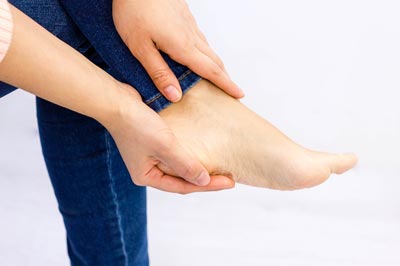Rehabilitation Exercises for Ankle Instability
Imagine walking along your favorite trail, enjoying the crisp air and the serene beauty of nature, when suddenly, your ankle gives way beneath you. The sharp pain radiates through your leg, and you’re forced to hobble back home, yet again sidelined by an unstable ankle. Ankle instability is not only a physical hindrance but also a mental burden that can limit your activities and dampen your spirit. However, there’s hope—through a structured rehabilitation program, you can restore your ankle’s strength and stability, reclaiming your confidence and freedom of movement. In this blog article, we’ll delve into the vital steps of rehabilitating an unstable ankle, helping you understand why each exercise is essential and how it contributes to your overall recovery. We will cover seven critical areas, each designed to address different aspects of ankle stability. Whether you’re recovering from a recent injury or managing chronic ankle instability, these exercises can make a significant difference in your journey toward a stronger, more resilient ankle.
Understanding Ankle Instability: The Biomechanics Behind It
Ankle instability is a condition characterized by a recurrent giving way of the outer side of the ankle, often due to previous injuries such as sprains. Understanding the biomechanics behind ankle instability is crucial for effective rehabilitation. The ankle joint is a complex structure comprised of bones, ligaments, tendons, and muscles working in harmony to provide support and facilitate movement. When an ankle sprain occurs, it typically involves the overstretching or tearing of the lateral ligaments that support the ankle. These ligaments, primarily the anterior talofibular ligament (ATFL) and the calcaneofibular ligament (CFL), are responsible for maintaining the ankle’s stability during weight-bearing activities.
Injuries to these ligaments compromise their integrity, leading to mechanical instability, which can manifest as a persistent feeling of the ankle giving way. This mechanical instability often results in altered joint mechanics and disrupted proprioception—the body’s ability to sense its position and movements. Proprioceptors, specialized sensory receptors located in the muscles and tendons around the ankle, send real-time feedback to the brain about the joint’s position. When these receptors are damaged or impaired due to injury, the brain receives inaccurate information, leading to poor coordination and delayed reflexes. This neuromuscular deficit further exacerbates the instability, making it difficult for the individual to maintain balance, especially on uneven surfaces or during dynamic movements.
Effective rehabilitation exercises for ankle instability aim to address both mechanical and proprioceptive deficits. Strengthening the surrounding muscles, particularly the peroneal muscles, helps compensate for weakened ligaments, providing additional support to the joint. Additionally, proprioceptive training, such as balance exercises and agility drills, enhances the body’s ability to detect and respond to ankle movements accurately. Stretching routines to improve flexibility and range of motion are also essential to ensure that the ankle can move freely without compensatory patterns that may lead to further injury. By comprehensively addressing these biomechanical aspects, rehabilitation exercises can restore stability, reduce the risk of re-injury, and improve overall ankle function.

Rehabilitation Exercises for Ankle Instability
The Importance of Proprioception: Regaining Your Sense of Balance
Proprioception, often described as the body’s “sixth sense,” plays a pivotal role in maintaining balance and preventing injuries. It refers to the unconscious awareness of joint position and movement, allowing the body to react and adjust to changes in the environment swiftly. In the context of ankle instability, proprioception becomes even more critical. After an injury like an ankle sprain, the proprioceptors in the ligaments and muscles around the ankle can become damaged, impairing their ability to send accurate information to the brain about the joint’s position. This disruption leads to delayed muscle responses and compromised balance, making the ankle more prone to further injuries.
Rehabilitation exercises aimed at enhancing proprioception are essential for regaining stability and ensuring a full recovery from ankle instability. These exercises focus on retraining the neuromuscular system to improve coordination and reaction times. Balance training is a core component of proprioceptive rehabilitation. Simple exercises like standing on one leg can gradually be progressed to more challenging tasks, such as balancing on an unstable surface like a wobble board or balance pad. These activities force the ankle’s stabilizing muscles to work harder, thereby improving proprioceptive function and overall joint stability. Additionally, incorporating dynamic movements, such as hopping or doing lateral jumps, helps simulate real-life scenarios where quick adjustments are necessary.
Consistency and progression are key when it comes to proprioceptive training for ankle instability. Starting with basic exercises and gradually increasing the difficulty ensures that the ankle is not overwhelmed and can build strength and coordination progressively. It’s also important to integrate proprioceptive training into regular workouts to maintain the gains achieved during rehabilitation. By focusing on the importance of proprioception and incorporating targeted exercises, individuals can restore their sense of balance, reduce the risk of re-injury, and enhance their overall functional performance. Proprioceptive rehabilitation not only aids in the immediate recovery but also equips the body to better handle future challenges, ensuring long-term ankle health and stability.
Strengthening Key Muscles: Building a Solid Foundation
Strengthening key muscles around the ankle is fundamental to building a solid foundation for recovery from ankle instability. The primary stabilizers of the ankle joint include the peroneal muscles, tibialis anterior, gastrocnemius, and soleus. These muscles work in concert to provide support and control during movement. When these muscles are weakened, the stability of the ankle is compromised, increasing the risk of further injuries. Targeted strengthening exercises can help reinforce these muscles, providing the necessary support to the weakened ligaments and improving overall joint stability.
One essential exercise for strengthening the peroneal muscles is the peroneal stretch and resistance band exercises. To perform a basic resistance band exercise, loop the band around your foot and anchor it to a stable object. Pull the band towards you, and then push your foot away against the band’s resistance. This movement targets the peroneal muscles, which play a crucial role in preventing the ankle from rolling outward. Additionally, calf raises are excellent for strengthening the gastrocnemius and soleus muscles. By standing on the edge of a step and slowly raising and lowering your heels, you engage the calf muscles, enhancing their ability to support the ankle during dynamic activities.
Incorporating compound exercises that mimic real-life movements can also be beneficial. For instance, lunges and squats not only strengthen the lower leg muscles but also improve balance and coordination. These functional exercises engage multiple muscle groups simultaneously, promoting better muscle synergy and joint stability. It’s important to start with controlled, slow movements and gradually progress to more challenging variations as strength improves. Consistency in performing these exercises ensures that the muscles surrounding the ankle become robust enough to handle daily activities and sports demands without giving way.
By focusing on strengthening key muscles, individuals can build a solid foundation that enhances ankle stability and reduces the likelihood of re-injury. A well-rounded rehabilitation program that includes targeted resistance exercises, functional movements, and consistent practice will lead to improved muscle strength, better proprioception, and overall enhanced ankle function. Through dedication and proper technique, the journey to overcoming ankle instability becomes significantly more achievable, allowing individuals to return to their active lifestyles with confidence.

Foot Bones Maintenance Exercises
Flexibility and Range of Motion: Ensuring Full Recovery
Flexibility and range of motion are critical components in the rehabilitation process for ankle instability, playing an essential role in ensuring full recovery. After an injury, it’s common for the ankle joint to become stiff and lose its natural range of motion due to swelling, scar tissue formation, and disuse. This restriction can, in turn, affect gait patterns and overall mobility, creating compensatory movements that may lead to further injuries. Therefore, incorporating flexibility and range of motion exercises into a rehabilitation program is key to restoring normal function and preventing chronic instability.
One effective way to improve flexibility and range of motion is through targeted stretching exercises. Stretching the Achilles tendon and calf muscles is particularly important, as these areas often become tight following an ankle injury. Performing a wall stretch by placing hands on a wall, extending one leg back, and pushing the heel towards the ground can help alleviate tightness in the calf and Achilles. Additionally, seated towel stretches, where a towel is looped around the foot while gently pulling it towards oneself, can enhance the dorsiflexion range of the ankle. These stretches should be performed consistently and held for at least 20-30 seconds to allow the muscles and tendons to relax fully and lengthen.
In addition to static stretching, dynamic range of motion exercises are indispensable for regaining full ankle mobility. Ankle circles, where the foot is moved in circular motions, and alphabet exercises, tracing letters with the toes, are simple yet effective ways to mobilize the ankle joint through various planes of motion. Using tools like balance boards or stability balls can add an element of instability, further challenging and enhancing joint mobility. Regularly performing these exercises helps break down adhesions and promote synovial fluid production within the joint, which lubricates and nourishes the cartilage, facilitating smoother and more pain-free movements.
Ensuring flexibility and a full range of motion is not merely about recovering from an injury but also about restoring confidence in the ankle’s ability to perform. A well-rounded rehabilitation program that prioritizes these aspects can significantly reduce the risk of re-injury and improve overall functional performance. By dedicating time to both static and dynamic exercises, individuals can achieve a more resilient and responsive ankle, enabling them to return to their preferred activities with greater ease and stability.
Balance Training: Stability on Unstable Surfaces
Balance training is a crucial element in the rehabilitation of ankle instability, focusing on improving stability on unstable surfaces. This type of training enhances proprioception—the body’s ability to sense its position in space—by challenging the body’s balance and coordination systems. When you train on unstable surfaces, your muscles and neurological pathways are forced to work harder to maintain equilibrium, translating to better control and stability in everyday activities. Exercises such as standing on a wobble board or using a balance pad can significantly enhance proprioceptive feedback and improve the neuromuscular coordination necessary to stabilize the ankle.
Starting with basic balance exercises, such as single-leg stands on a flat surface, helps build the foundational strength needed for more complex movements. As confidence and competence grow, progressing to unstable surfaces adds an additional layer of challenge. For example, performing single-leg stands on a balance pad or wobble board forces the ankle’s stabilizing muscles to engage more intensely, promoting joint stability and reducing the risk of future sprains. Dynamic movements like lateral hops or toe touches while balancing on one foot further enhance these skills by simulating real-life activities that require sudden adjustments and quick reflexes.
Incorporating balance training into a regular rehabilitation program not only aids in recovering from ankle instability but also builds resilience against future injuries. Consistency is key; regular practice ensures that the improvements in balance and stability become ingrained in the body’s movement patterns. Moreover, these exercises can be tailored to individual needs, gradually increasing in complexity as strength and stability improve. By systematically incorporating balance training, individuals can achieve a higher level of ankle stability, better prepare for dynamic activities, and ultimately reclaim confidence in their movement. The goal is to create a robust foundation of proprioceptive and neuromuscular control that supports a lifetime of healthy, active living.

Ankle Instability Rehabilitation
Agility Drills: Preparing for Dynamic Movements
Agility drills are a vital component of rehabilitation for ankle instability, specifically designed to prepare the ankle for dynamic movements encountered in daily activities and sports. These drills focus on improving quickness, coordination, and the ability to change direction swiftly and efficiently. By incorporating agility exercises into a rehabilitation program, individuals can train their ankles to respond more effectively to sudden shifts in momentum, reducing the likelihood of re-injury. The key is to simulate real-life scenarios that challenge the body’s ability to maintain stability while performing rapid, multi-directional movements.
One foundational agility drill is the ladder drill, which involves stepping in and out of the rungs of a ladder laid flat on the ground. This exercise promotes quick footwork and enhances ankle coordination by requiring precise, controlled movements. Cone drills, where participants weave through a series of cones set up in various patterns, also offer excellent agility training. These drills not only improve lateral movement and directional changes but also engage the core and lower body muscles, contributing to overall stability. Incorporating jumps and hops, such as single-leg hops over cones or onto platforms, adds a plyometric element to the training, further strengthening the ankle and enhancing its ability to absorb and dissipate forces.
Progression and variety are crucial when implementing agility drills in a rehabilitation program. Starting with simpler drills and gradually advancing to more complex and faster-paced exercises ensures that the ankle adapts safely without being overstrained. For athletes, sport-specific agility drills can be particularly beneficial, mimicking the movements and demands of their particular sport. This targeted approach helps bridge the gap between rehabilitation and return to play, ensuring that the ankle is not only stable but also capable of performing at a high level. Consistent practice of these drills fosters confidence in the ankle’s ability to handle dynamic movements, ultimately leading to improved performance and a lower risk of future injuries.
In conclusion, agility drills are indispensable for preparing the ankle for the dynamic and unpredictable nature of physical activities. They enhance quickness, coordination, and directional control, all of which are critical for maintaining ankle stability. By systematically integrating these drills into a rehabilitation routine, individuals can achieve a higher level of functional performance, ensuring that their ankles are well-equipped to handle the demands of both everyday life and athletic pursuits. The ultimate goal is to create a resilient, responsive ankle that supports safe and effective movement in all situations.
Progression and Consistency: Keys to Long-Term Success
Progression and consistency are the cornerstones of a successful treatment of ankle instability. Rehabilitation exercises need to be systematically advanced to ensure that the ankle continues to adapt and strengthen over time. Starting with basic exercises that focus on range of motion and simple balance tasks sets the foundation for more complex activities. It’s essential to gradually increase the difficulty and intensity of these exercises, allowing the body’s musculoskeletal and neuromuscular systems to adjust without being overwhelmed. For example, beginning with seated ankle circles and progressing to single-leg stands on an unstable surface can provide a structured pathway to recovery.
Consistency is equally important in achieving long-term success in ankle rehabilitation. Regular, dedicated practice of rehabilitation exercises ensures that the gains made in strength, flexibility, and proprioception are maintained and reinforced. It’s not enough to perform these exercises sporadically; they need to be incorporated into a daily or weekly routine. Consistent engagement in balance training, strength exercises, and agility drills helps to solidify muscle memory and enhance the body’s ability to respond to dynamic movements. This habitual practice fosters resilience in the ankle joint, making it less susceptible to future injuries.
Monitoring progress and setting incremental goals can also help maintain motivation and track improvements. Keeping a rehabilitation diary or working with a physical therapist can provide valuable feedback and adjustments to the exercise regimen as needed. It’s crucial to celebrate small milestones along the way, as they signify steps toward full recovery. By adhering to a progression-based approach and maintaining consistency, individuals can achieve significant, lasting improvements in ankle stability. This disciplined strategy not only addresses current instability but also builds a robust framework for preventing re-injury, ensuring that the benefits of rehabilitation extend well into the future.

Ankle Instability Recovery
Conclusion
Rehabilitation exercises for ankle instability are not just about regaining strength; they’re about reclaiming your life and the activities you love. Through a comprehensive approach that includes understanding the biomechanics of your injury, enhancing proprioception, strengthening key muscles, improving flexibility, incorporating balance training, and practicing agility drills, you can rebuild a stable and resilient ankle. Remember, consistency and progression are the linchpins of a successful rehabilitation program. With dedication and the right exercises, you’ll be back on your feet, stronger and more confident than ever before.
Flagstaff Foot Doctors: Anthony Rosales DPM
https://www.google.com/maps?cid=8835841318590452161
421 N Humphreys St, Flagstaff, AZ 86001, United States
(928) 774-4825
https://flagstafffootandankle.com/
